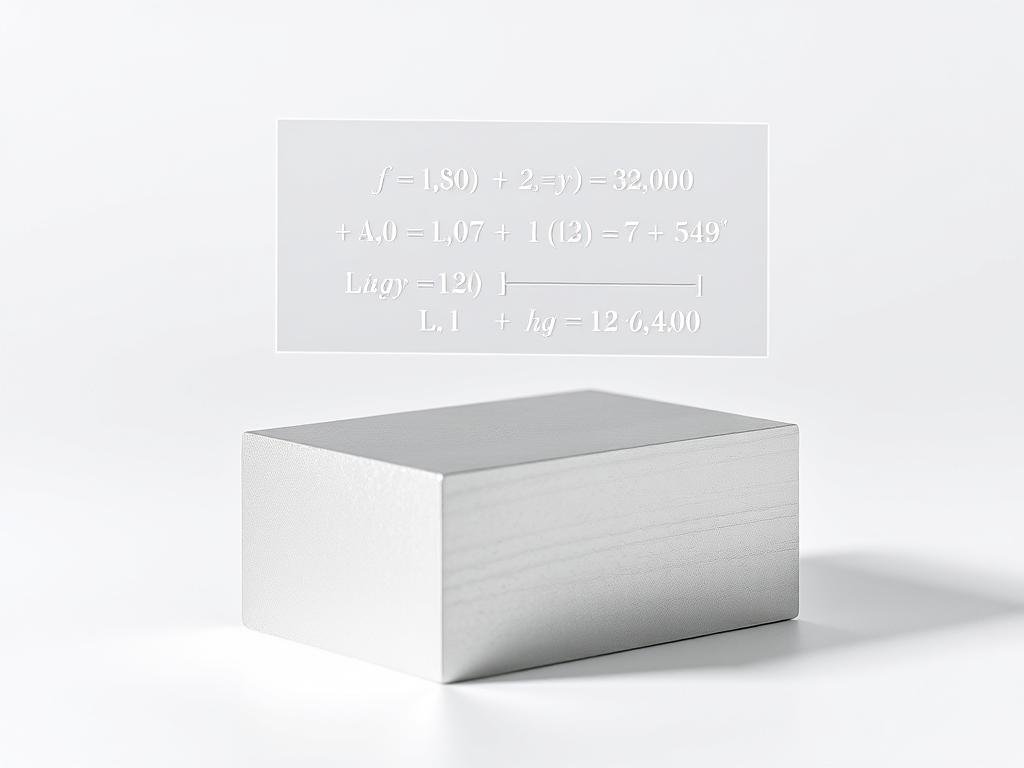Understanding the properties of aluminum is crucial for professionals working on projects that require precise material specifications.
The density of pure aluminum is approximately 2.70 grams per cubic centimeter (g/cm³), which is equivalent to 0.0975 pounds per cubic inch (lb/in³). This value can vary slightly depending on the specific alloy.
Aluminum’s relatively low density makes it a popular choice for applications where weight reduction is important. This comprehensive guide will explore aluminum’s properties and provide essential conversion information for professionals working across different measurement systems.
By understanding the exact value of aluminum density, engineers and manufacturers can ensure precision in their projects, particularly in industries like aerospace where material specifications are critical.
Understanding Aluminum Density
To appreciate aluminum’s versatility, it’s essential to understand its density and related properties. Aluminum density is a critical factor in its application across various industries, from aerospace to construction.
What is Density and Why It Matters
Density is defined as mass per unit volume of a substance. It’s a fundamental property that influences how materials are used in engineering and manufacturing. Aluminum’s relatively low density makes it an attractive material for applications where weight reduction is crucial. The natural formation of a protective oxide layer on aluminum’s surface provides inherent corrosion resistance, eliminating the need for additional protective coatings in many applications.
Basic Properties of Aluminum
Aluminum possesses a unique combination of properties, including its low density, good strength-to-weight ratio, and excellent corrosion resistance. Its thermal conductivity is around 235 W/m·K, and its electrical conductivity is about 60% that of copper. The melting point of aluminum is approximately 660.3°C, making it easier to cast and form compared to many other structural metals. The mechanical properties of aluminum can be significantly modified through alloying with various elements and through heat treatment processes.
The Density of Aluminum in lb/in³
Understanding aluminum’s density in lb/in³ is essential for engineers and designers working with this versatile metal. The density of aluminum is a fundamental property that influences its application across various industries, from aerospace to consumer electronics.
Standard Density Value in Imperial Units
The standard density of aluminum is approximately 0.098 lb/in³. This value is crucial for calculations involving the weight and volume of aluminum components. Aluminum’s density in imperial units is a key factor in determining the material’s suitability for specific applications where weight reduction is critical. For instance, in the aerospace industry, the density of aluminum directly impacts fuel efficiency and payload capacity.

Practical Significance of Aluminum’s Low Density
Aluminum’s low density provides substantial advantages in applications where reducing weight is important. It offers good strength while remaining relatively lightweight, making it ideal for aerospace, automotive, and portable applications. The material’s naturally forming protective oxide layer also makes it resistant to corrosion, further enhancing its performance and longevity.
The practical significance of aluminum’s low density can be seen in several areas:
- Weight savings in structural applications, allowing for the design of lighter components that maintain adequate strength for their intended purpose.
- Revolutionizing aircraft design in the aerospace industry by enabling the construction of lighter airframes that require less fuel to operate.
- Improving fuel efficiency and reducing emissions in the automotive sector while maintaining structural integrity and crash performance.
- Creating a premium feel without excessive heaviness in consumer electronics, explaining its popularity in portable and handheld devices.
The energy required to transport aluminum components is significantly less than that needed for steel equivalents, creating cascading efficiency benefits throughout the supply chain and product lifecycle.
Aluminum Density in Metric Units
The density of aluminum in metric units is a fundamental characteristic that influences its use in different industries. Aluminum’s density is typically measured in grams per cubic centimeter (g/cm³) or kilograms per cubic meter (kg/m³).
Density in g/cm³ and kg/m³
Aluminum has a density of approximately 2.70 g/cm³, which translates to 2700 kg/m³. This density value is crucial for engineers and designers who need to calculate the weight of aluminum components for various projects. The relatively low density of aluminum makes it an attractive material for applications where weight reduction is critical.
Comparing Aluminum to Other Common Metals
When comparing aluminum to other metals, its density becomes even more significant. For instance, steel has a density of about 7.85 g/cm³, making aluminum roughly one-third the weight of steel for the same volume. Copper, with a density of around 8.96 g/cm³, is even denser than steel, while magnesium is lighter than aluminum at 1.74 g/cm³.
- Aluminum’s density positions it as a medium-light metal, significantly lighter than steel and copper but heavier than magnesium.
- The density comparison explains why aluminum often replaces steel in weight-critical applications, offering approximately 66% weight savings.
- Copper’s higher density comes with superior electrical conductivity, but aluminum’s conductivity-to-weight ratio makes it efficient for power transmission lines.
These comparisons highlight the importance of density in material selection, influencing factors such as weight, strength, conductivity, and corrosion resistance.
Converting Aluminum Density Between Metric and Imperial Units
Understanding how to convert aluminum density between different unit systems is essential for accurate calculations in design and manufacturing. This conversion is particularly important in global projects where materials specifications may be provided in different units.
Conversion Formulas and Factors
To convert aluminum density from metric units (g/cm³) to imperial units (lb/in³), we use a conversion factor. The density of aluminum is approximately 2.70 g/cm³. To convert this to lb/in³, we multiply by 0.0361.
For the reverse conversion, from lb/in³ to g/cm³, we multiply by 27.68. These conversion factors are crucial for ensuring accuracy in calculations involving aluminum density.
| From | To | Conversion Factor | Example |
|---|---|---|---|
| g/cm³ | lb/in³ | 0.0361 | 2.70 g/cm³ × 0.0361 = 0.0975 lb/in³ |
| lb/in³ | g/cm³ | 27.68 | 0.0975 lb/in³ × 27.68 = 2.70 g/cm³ |
Step-by-Step Conversion Examples
Let’s consider a practical example: To find the weight of an aluminum block measuring 2 inches × 3 inches × 4 inches, we first calculate its volume as 24 cubic inches. Then, using the density of aluminum (0.0975 lb/in³), we find its weight to be 24 in³ × 0.0975 lb/in³ = 2.34 pounds.
For sheet metal applications, if we have a 0.125-inch thick aluminum sheet, its weight per square foot can be calculated by multiplying the thickness by the area and the density, resulting in 0.125 in × 1 ft² × 0.0975 lb/in³ = 1.76 lb/ft² after appropriate unit conversions.
- To convert 2.70 g/cm³ to lb/in³, we use the conversion factor 0.0361, resulting in 0.0975 lb/in³.
- For the reverse, 0.0975 lb/in³ is converted to g/cm³ by multiplying by 27.68, giving 2.70 g/cm³.
- When converting to kg/m³, remember that 1 g/cm³ equals 1,000 kg/m³, so 2.70 g/cm³ equals 2,700 kg/m³.
Density Variations Among Aluminum Alloys
Understanding the density variations among different aluminum alloys is crucial for selecting the right material for specific applications. Aluminum alloys are widely used in various industries due to their unique combination of properties, including strength, corrosion resistance, and density.
Common Aluminum Alloy Series and Their Densities
Aluminum alloys are categorized into several series based on their primary alloying elements. The most common series include the 1000, 2000, 3000, 5000, 6000, and 7000 series. Each series has its own density characteristics, influenced by the type and amount of alloying elements.
For instance, the 1000 series, being relatively pure aluminum, has a density close to that of pure aluminum, around 2.7 g/cm³. In contrast, the 2000 series, alloyed with copper, and the 7000 series, alloyed with zinc, tend to have higher densities due to the higher atomic masses of these elements.
| Alloy Series | Primary Alloying Element | Typical Density (g/cm³) |
|---|---|---|
| 1000 | – | 2.70 |
| 2000 | Copper | 2.80 |
| 5000 | Magnesium | 2.66 |
| 7000 | Zinc | 2.85 |
Factors Affecting Aluminum Density
Several factors can influence the density of aluminum alloys, including alloying elements, temperature, manufacturing processes, and microstructural characteristics. Alloying elements with higher atomic masses than aluminum, such as copper and zinc, increase the alloy’s density, while lighter elements like lithium and magnesium can reduce it.
Temperature affects aluminum density through thermal expansion. As temperature increases, aluminum expands and becomes less dense. Manufacturing processes, such as casting, can introduce porosity, reducing the effective density of the final product. Additionally, heat treatment and cold working can alter the microstructure, causing minor changes in density.
By understanding these factors and their impact on density, engineers and designers can make informed decisions when selecting aluminum alloys for their applications, ensuring optimal performance and efficiency.
Practical Applications of Aluminum Density Calculations
The density of aluminum plays a crucial role in various engineering and manufacturing applications. Understanding its density is essential for making informed decisions about material selection, weight estimation, and cost calculations.
Engineering and Design Considerations
In engineering and design, aluminum density is a critical factor in determining the structural integrity and weight of components. Accurate density measurements enable engineers to optimize designs, ensuring that they are both strong and lightweight. For instance, in aerospace applications, minimizing weight while maintaining strength is paramount, and aluminum’s density is a key consideration.
| Application | Density Consideration | Benefit |
|---|---|---|
| Aerospace | Low density for weight reduction | Improved fuel efficiency |
| Automotive | Balancing density and strength | Enhanced performance and safety |
| Construction | Density for structural integrity | Durability and stability |
Weight Estimation for Manufacturing and Transportation
Accurate weight estimation based on aluminum density is vital for manufacturing planning, shipping logistics, and cost calculations. The basic formula for weight calculation (Weight = Volume × Density) can be applied to any aluminum component. For example, an aluminum block with dimensions 10 cm × 10 cm × 10 cm has a volume of 1,000 cm³. Multiplying this volume by the density of 2.70 g/cm³ gives a mass of 2,700 grams or 2.7 kg.
Modern manufacturing software often incorporates density values to automatically calculate component weights from 3D models, streamlining the estimation process and reducing errors. This automation is particularly beneficial for complex geometries where manual calculations might be cumbersome or prone to errors.

Conclusion
The significance of aluminum density, whether in g/cm³ or lb/in³, cannot be overstated in modern engineering. Understanding that aluminum’s mass density is approximately 2.70 g/cm³ (0.0975 lb/in³) is crucial, though it’s essential to note that this value can vary slightly with different alloys.
Professionals working across international boundaries must be adept at converting between metric and imperial units. The relatively low density of aluminum drives its adoption in weight-sensitive applications. While pure aluminum has a standard density, alloys exhibit variations, typically ranging from 2.66 to 2.81 g/cm³.
Maintaining precision during unit conversions is vital. As lightweight design becomes increasingly important for energy efficiency, understanding aluminum density and its practical applications will remain valuable across numerous industries.
